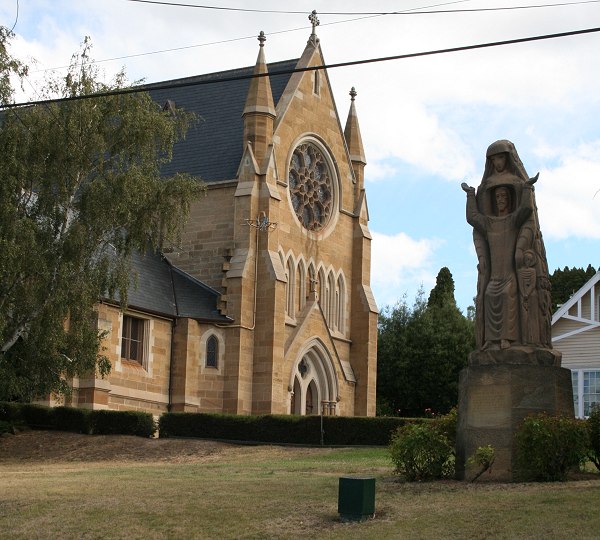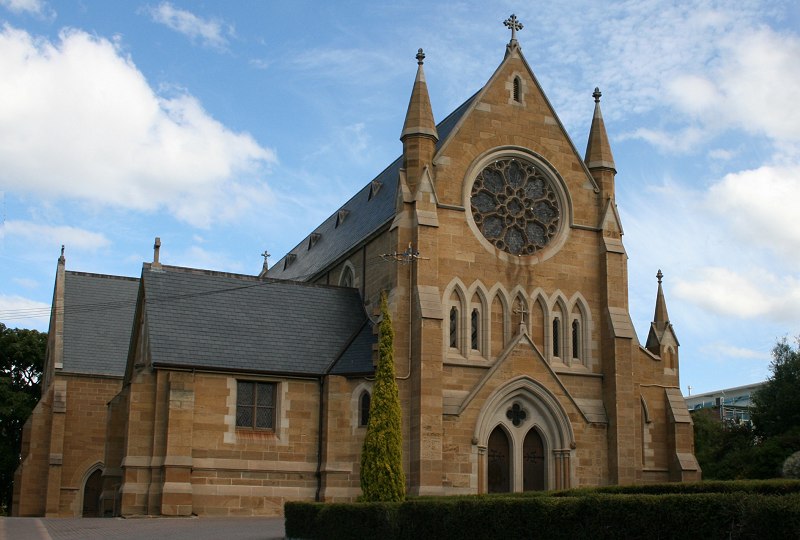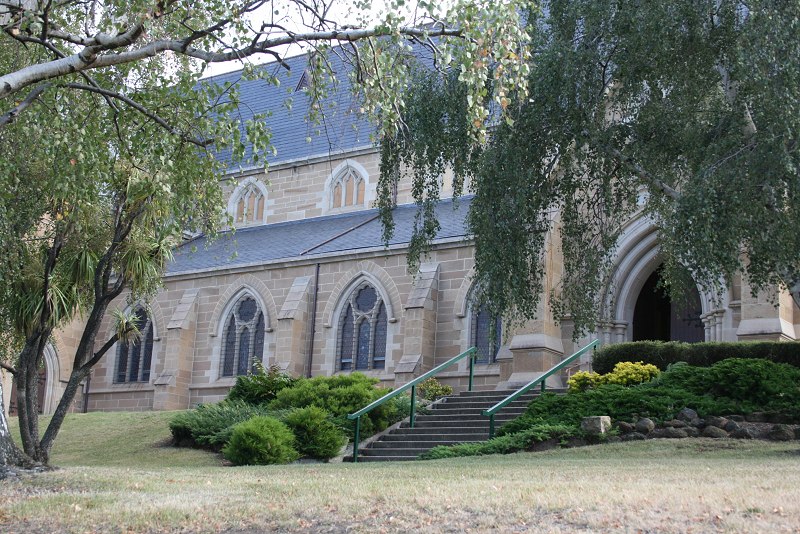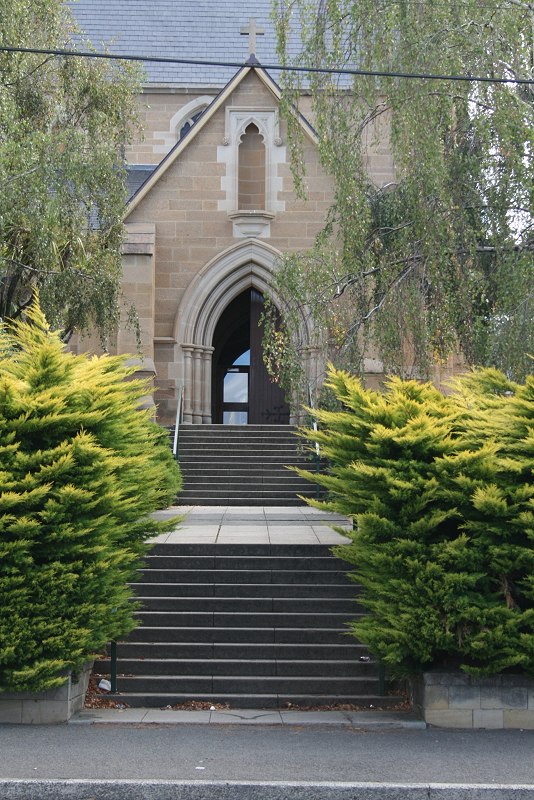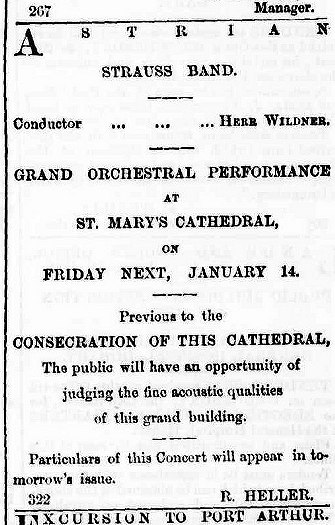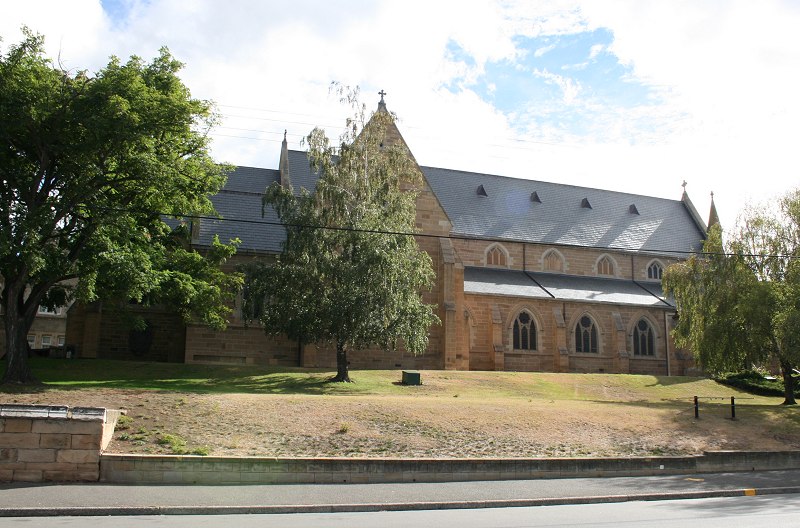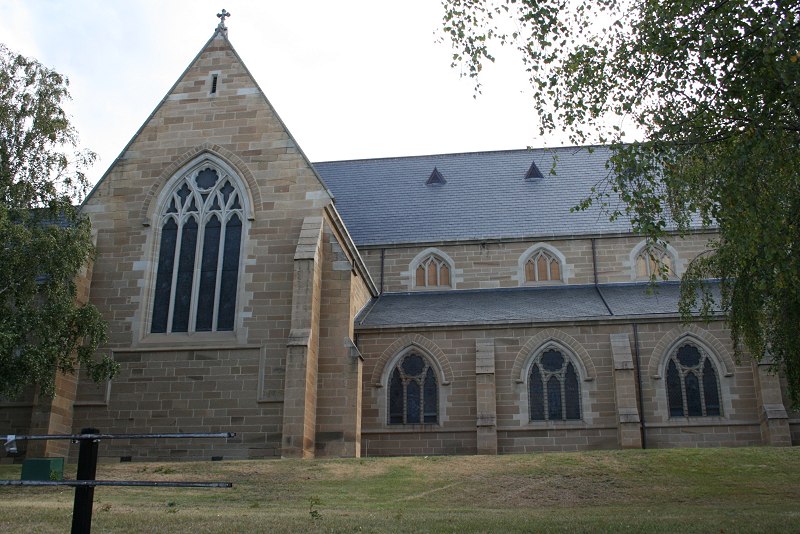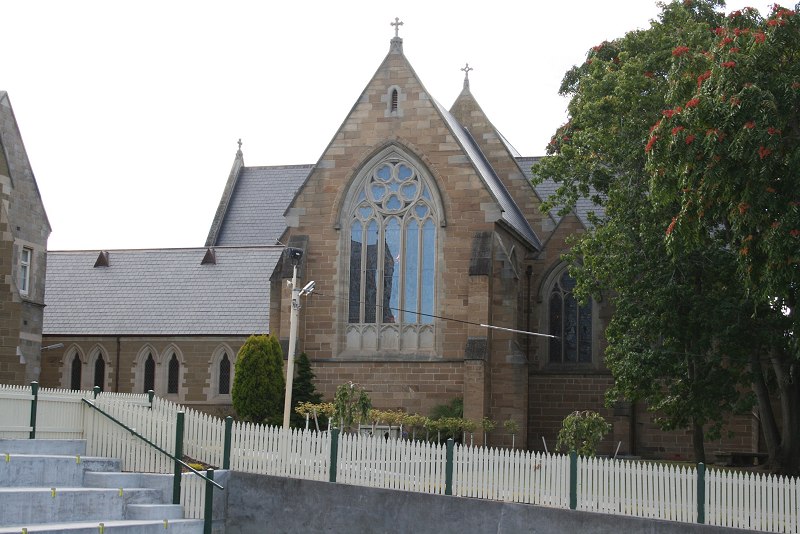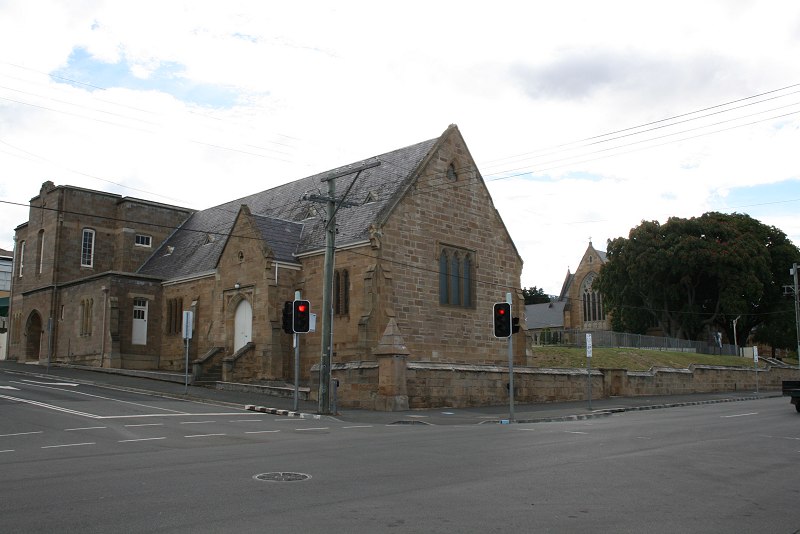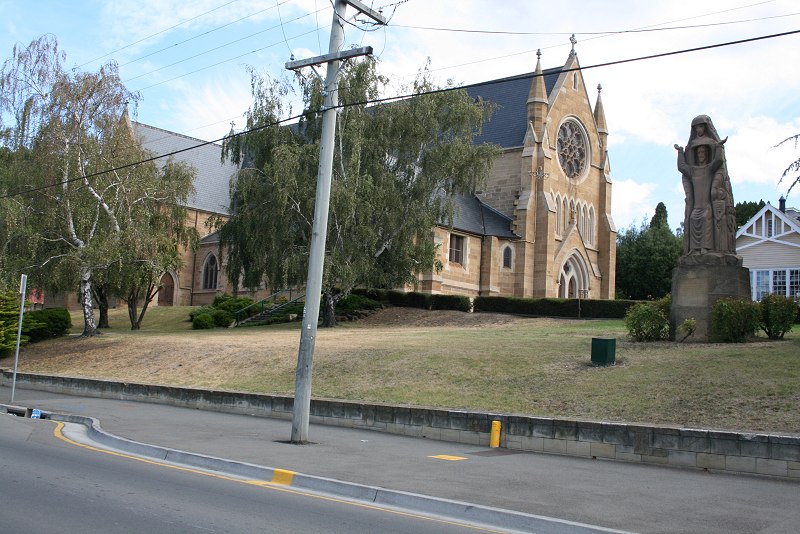Originally opened in 1866, then rebuilt and reopened in 1881.
First part of this post deals with original building. Current building & photos are in second part of post.
Some background on the development of the Catholic church in Hobart.
Google Maps
History & features on Archdiocese website
Wikipedia page
Memorial Window
Organ
The erection of St. Mary’s Cathedral had engaged the attention of Bishop Willson throughout a great part of his episcopate. Mr. Roderic O’Connor had donated £10,000, £5,000 had been contributed from other sources, and on September 12, 1860, the foundation-stone was laid. Among those present upon that occasion were the Governor and Lady Fox Young, attended by Mr. N. Maule, A.D.C., and Major Douglas. The ceremony was an imposing one, and in the evening there was a Banquet at St. Peter’s-hall, in Collins-street, at which the Bishop presided, and among those present were Major Douglas, Mr. John Davies, M.H.A., Mr. Balfe, M.H.A., Mr. H. Hunter, and Mr. John O’Boyle. On the 4th July, 1866, Bishop Murphy having succeeded Bishop Willson, the dedication took place, the preacher being Dr. Shield the Bishop-elect of Adelaide.
Extract from “Hobart Churches”, The Mercury, 31 December 1904
Three photos of St Mary’s during construction: 1, 2 & 3
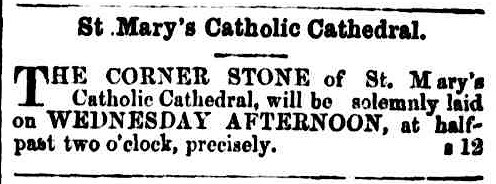
The Mercury, 10 September 1860
ST. MARY’S CATHOLIC CATHEDRAL
THE LAYING THE FOUNDATION STONE.
The Corner Stone of the new Cathedral in Harrington-street, was solemnly laid by the Right Rev. Dr. Willson, Bishop of Hobart Town, yesterday, in the presence of a very large number of the citizens and inhabitants of the surrounding districts, there being present during the proceeding nearly three thousand persons.
The children of the Catholic Schools assembled, the girls at St. Joseph’s, and the boys in St. Peter’s Hall, at one o’clock, and preceded by a band and accompanied by banners, marched to the ground. At half-past two o’clock His Excellency the Governor and Lady Young arrived at the entrance to the ground accompanied by H. Maule, Esq., Aid de Camp, Major Douglas, and other officers of the staff, where His Excellency was received by the Reverend Fathers Hunter, Butler, Hogan, Dunn, and Burke, and Mr. Henry Hunter, Superintending Architect of the Works, who conducted his Excellency and Lady to a Marquee near the Chancel end of the proposed building.
The Right Rev. Dr. Willson arrived almost at the same moment in full canonicals with mitre and pastoral staff, preceded by the Cross-bearer, and Acolytes, and in addition to the above-named reverend gentlemen, the Rev. Fathers Woods ,Murphy, Ryan, and Keohan, His Lordship proceeding to the chancel angle, at which the ponderous corner stone of the Cathedral was suspended.
The hymn “Jesus the only thought of Thee” was then sung by the choristers, the Bishop during the continuance of the hymn pronouncing the usual form of blessing over the stone. The ceremony of laying the corner stone was then commenced.
[Continued]
The Mercury, 13 September 1860
OPENING OF ST. MARY’S CATHEDRAL.
St. Mary’s Cathedral was formally opened on Wednesday, the 4th instant. It is built in the Gothic style of the decorated period. The portions at present built are the north and south Transepts, three Chancels, and the small Chapels. The Lantern Tower now rises from the centre, of the Transept. When the edifice is completed it will spring from the intersection of the Navc, the Chancel, and Transepts. The height, of the tower or lantern is about a hundred feet. The transepts are eighty-two feet long, and fifty four feet in height. The chancel is proportionate in its dimensions. The tower is a hundred feet high. All the window heads are filled with elaborate and graceful tracery. And the high altar is temporarily fitted up with a rerados containing diaper panels. Altogether, there is a lightness, a harmony, and a uniformity about the interior of the cathedral, even in its present unfinished state which renders it very pleasant to the sight, even when unacompanied by the imposing ceremonies and elevating sacred music of yesterday.
We have used the plural, ceremonies, advisedly. For there were two. The first commenced at eight O’Clock in the morning. At this hour the Vicar General, assisted by a number of the clergy, formally dedicated the, cathedral in accordance with the customary rites During this time, in compliance with the prescriptions of the Roman Catholic Rubric, the doors were closed. Immediately, however, after its conclusion, they were then opened to the public. And shortly before 11 o’clock the general, interest shown in the ceremony that was about to take place was evinced by the number of persons that thronged to the doors. The interior of the cathedral itself presented a must striking appearance. The altar decorated with flowers, the unusual assembly of priests in their various robes, corresponding with their several ecclesiastical ranks, the number of persons of all congregations that were gathered together, the solemnity of the service, and the effect of the sacred music performed with so much taste, and so much purity, must have left their impression upon the most listless attendant.
[Continued]
Cornwall Chronicle, 25 July 1866
PHOTOS
St Mary’s Cathedral
St Mary’s Cathedral, 1869
View of Hobart c1878 with St Mary’s on right
The building to all appearance was a noble one, but defects soon became apparent, and finally a committee of architects declared, to the keen disappointment of the people, that it was unsafe. In 1876 a public meeting, convened by the Bishop, and presided over by the Governor (Sir P. A. Weld) decided that the building would have to be taken down and re-erected, a work which involved an expenditure of £10, 000. The labour of years had been in vain, and it might have been anticipated that the ardour of the people would have been lessened. Not so. The Catholics were not content to chant “Day by day we magnify Thee, and we worship Thy Name ever world without end” in a barn. They recognised the painfulness of the incongruity, and resolved to make another commencement. Being free from schism and strife, and able to unite for a common purpose in the cause of the Cross, as other men only appear able to do in the cause of the dollar, they succeeded. Were this land blighted at its present stage, as Greece has been, or Spain, there would remain many magnificent temples erected in the service of Mammon. Thanks to the Catholics, there would be one temple dedicated to God. On January 23, 1881, the church was rededicated by Bishop Murphy, having been closed since May, 1876. New plans had been prepared by Mr. Henry Hun-ter, and the work of erecting the building entrusted to the Messrs. Shields.
Extract from “Hobart Churches”, The Mercury, 31 December 1904
On Sunday afternoon the ceremony of blessing the foundation stone of St. Mary’s Cathedral, Hobart Town, took place. This building has been partly built, and then the greater part had to be pulled down. The tender of Mr Rippon was accepted for certain parts of the rebuilding at £5, 995, but the portion not contracted for at present, which includes a tower at the N.E. end 200ft high, is estimated to cost another £3000 0r £4000. The dimensions of the building are:–Length, 151ft in the clear ; width of the nave 22ft ; ditto of each aisle 12ft 6in in the clear ; the transepts 27ft by 22 ft ; width of walls above the ground, 2ft 6in, the floor of the new building to be of wood. The aisle walls to be 17ft, and those of the nave, 33ft ; the pillars octagon 1ft 9in, and their height 10ft, with moulded caps ands moulded arches on the top. Considerable progress has been made with the work already. It took two or three months to take down the tower, and the outer walls are built up to the level of the springing of the windows. About thirteen months have already been occupied by the contractor, and it is expect to be at least two more years before the structure is completed.
Launceston Examiner, 12 February 1878
ST. MARY’S CATHEDRAL. The fourth Sunday of this month, the 23rd inst., has been, says the Catholic Standard, fixed upon for the solemn reopening of our Cathedral Church. On the 28th May, 1876, St. Mary’s was closed to the public in order to allow of alterations and additions being made, which, after mature deliberation, were deemed absolutely necessary. Some diversity of opinion was at first expressed as to the advisableness of demolishing the lantern tower, the most conspicuous feature in the original design; but as stone after stone was removed, revealing the scandalous state of the masonry, the wisdom of the course adopted was admitted by all. New plans were prepared by Mr Hunter, differing in many respects from the original design furnished by Mr Wardell in 1860. The Cathedral as now completed provides all the space for both congregation and ceremonies (except the baptistry) combined in the entire plan of the building, the only portions remaining unfinished being the western front of the nave, the baptistry at the end of the south aisle, and the tower and spire at the west end of the north aisle.
[Continues with detailed description]
Launceston Examiner, 8 January 1881
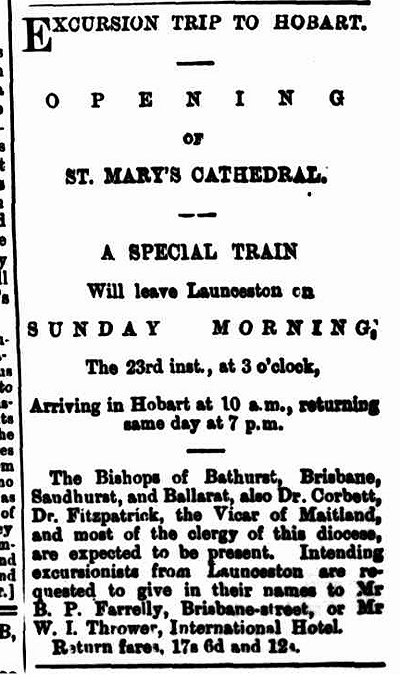
Launceston Examiner, 20 January 1881
RE-OPENING OF ST. MARY’S CATHEDRAL.
The ceremonies connected with the re-opening and dedication of St. Mary’s (R.C.) Cathedral, Harrington-street, were performed yesterday with the elaboration and pomp with which the adherents of that Church are accustomed to surround their sacred mysteries.
…
As the new building approached completion invitations were sent out by the Bishop of the diocese to the prelates and other distinguished persons in the neighbouring colonies, inviting their attendance at the dedication ceremony, and in response there was a large and influential attendance from the other side of the Straits, and the services were consequently very imposing. The attendance was very large. The day was a bright one, and the convenience afforded by the Main Line Railway manager and Mr. Webster, proprietor of the Huon coaches, enabled large numbers of Catholics in the Midland districts and the South to attend the ceremonies. The cathedral being kept empty until it had been blessed, the grounds around it became soon after 10 o’clock the scene of activity and gathering from all points of the compass. At about 20 minutes past 10 o’clock a procession issued from the sacristy door, led by Dean Beechinor (who throughout the whole of the proceedings acted as Master of the Ceremonies), and passed between a long line of members of the Hibernian Society, who were drawn up on either side, standing bareheaded and wearing their regalia. The procession consisted of crucifer, with acolytes, bearing candles ; the choir ; the clergy ; and His Lordship, Bishop Murphy, who was attired in cope and mitre, and bore the pastoral staff. This procession wound its way around the outside of the church, intoning the service appointed for such occasions, and the Bishop sprinkling the walls with holy water. A similar ceremony was observed inside the building, and then the general public were admitted, and very soon every available seat was occupied.
[Contined, very long article]
The Mercury, 24 January 1881
PHOTOS
Harrington St outside St Mary’s 1890s
Two postcards
Photo from behind
Funeral of A G Ogilvie, 1939, shows inside of cathedral
